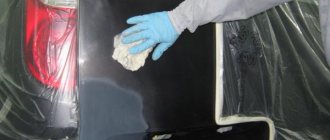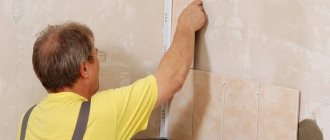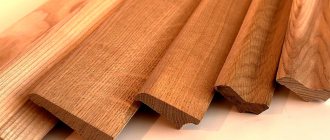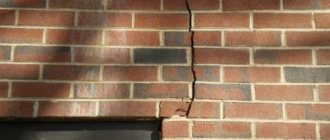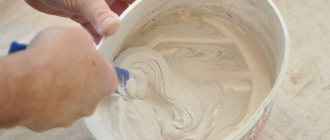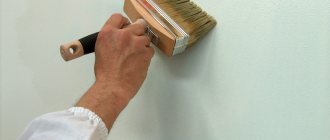How to drill a concrete wall correctly
First of all, we need to decide on the tool with which we will drill the wall - the choice is between a drill and a hammer drill. If you have only one of these tools at your disposal, then the agony of choice disappears by itself, but for those who plan to rent equipment, let us remind you that a hammer drill is a device designed specifically for this type of work, and therefore in most cases it is better suited. And the available range of output section sizes is much larger than that of a drill.
But a drill also has its advantages, for example, when it comes to foam concrete structures, a hammer drill will simply crumble such a base. Remember that the drill must be an impact drill; an unimpacted one will not produce results and will most likely be damaged. Therefore, if you are wondering whether it is possible to drill through a concrete wall with a drill, then know that the answer depends on the type of drill and the material of the wall itself.
Drill
An impact drill differs from the more common hammerless drill in that the movement of the drill in it is carried out using special ratchets with teeth. It is very simple to use; you just need to switch the tool to impact rotation mode and get down to business. An even more important component for success are suitable attachments for our task - drills; read their list in one of the paragraphs below.
In addition to choosing the right tool and consumables for it, we note a couple more features of drilling concrete walls with a drill. If you decide to work with a hammerless drill, then stop while drilling and help with your hands, driving the pointed drill in with a hammer, then continue using the drill. If the drill is low-powered, then let it rest often to avoid overheating.
Read also: Hexagon inscribed in a circle formula
In general, nothing is impossible, and with desire and diligence, you will certainly be able to cope with a wall, having in your arsenal tools that are not entirely suitable for this, but remember that if the surface does not give in, it is better to postpone the idea if you do not want to say goodbye to your drill.
Hammer
With this tool everything is simple:
- First, we check its serviceability and clean the barrel shaft of debris.
- Insert the drill until it clicks
- We bring the tool perpendicular to the wall and begin to drill, applying a little pressure. If the process takes a long time, we moisten the drill with plain water from time to time so that it does not overheat.
- If the drill gets stuck, then we simply take it out of the hammer drill, insert a tool of smaller diameter and try to use it to free the stuck object by widening the hole.
What drills are suitable?
As promised, we are considering drills suitable for our venture. The following will suit us:
- Drills for concrete with a pobedit tip - cope well with the material due to the cutting edge made of teeth based on carbide alloys. The safety margin is enough even for drilling metal, but the impact mode quickly renders them unusable. If you need to make a hole between the reinforcement, this is the best option.
- The diamond bit for impactless drilling is a modern attachment that opens material of any strength due to diamond sputtering.
- KS crown - they have diamond crystals settled on the cutting edge, which makes them something between the two previous types.
A device for recessing into a wall surface - which one is better?
How to drill a hole in a wall – this question often arises for a beginner. Today it is not difficult to cope with such a task. If a person has at least minimal experience and uses modern electric tools in his work, he will definitely cope.
How to drill a hole in a wall correctly? It all depends on the surface material
To ensure that the room remains clean after all work, it is worth using a jig - thanks to it you can drill with a minimum amount of dust and dirt.
A hammer drill is perfect for creating holes in the wall if, for example, the wall needs to be insulated (or for other purposes) - professionals recommend using it. This technique easily copes even with high-strength materials; nothing better than a hammer drill for holes in the wall has yet been invented. But a high-quality tool is expensive, and almost no one buys it for home use. Another option for making holes in the wall is an electric drill, which has an impact effect.
Expert's comments
Now you know how and with what help to make a hole in the wall, but if you do not have experience in such work, first ask one of your more experienced friends to teach you how to use the equipment, otherwise the walls and the tool may become much less functional than they were before the work began.
Also remember that even though our grandfathers and great-grandfathers were able to carry out repair work of any kind and complexity with the help of one hammer, you and I still live in peacetime, when there is no shortage of tools. Therefore, if you decide to get a hole in the wall, but you only have a low-power drill at hand without a hammer function, you shouldn’t torture the walls and the device, but it’s better to wait a little and ask your friends about the presence of a hammer drill - you’ll probably be lucky. Oh yes, if you live in an apartment building and you are familiar with such a nuisance as having neighbors, then be merciful to them and do not start your drill exercises with the first roosters - they will be grateful to you.
Read also: Formula for calculating the weight of metal
Sooner or later, most people living in houses with concrete walls need to hang a cabinet, lamp, shelf or picture. At this point, the pressing question arises of how to drill through a concrete wall. It's no secret that every home master has encountered this problem at least once in his life, but not everyone knows how to solve it. Many bravely torture the drill and their own strength, but, not achieving the desired result, they give up everything until the next attempt to make a hole in the wall. But the drill eventually breaks, and the shelves remain standing somewhere in the corner of the room or collecting dust in the pantry. But there are still options - you just need to know them and be able to use them.
What do the professionals advise?
Concrete structures are quite strong and difficult to drill. In addition, quite often drills come across crushed stone, which is part of the concrete mixture from which wall and ceiling slabs are formed.
Holes in concrete have to be made quite often, especially during the process:
- finishing works;
- furniture installation;
- air conditioner suspensions;
- additional electrical wiring device;
- installation of plumbing.
There are two ways to solve the problem of holes in a concrete wall:
- an impact drill, or better yet a hammer drill, with a Pobedit drill bit;
- diamond drilling.
It is worth noting that it will not be possible to make a hole in a concrete wall with ordinary drills, so before starting work you need to purchase drills with specially soldered plates made of high-strength pobedit alloy, which do an excellent job with concrete and brick. But it is not recommended to use them for soft materials, since pobedit drills do not cut them, but crumble them.
Precautionary measures
Of course, anyone can drill a couple of small holes in a concrete wall. It is enough to have a good drill with an impact function or a hammer drill, as well as a Pobedite or diamond drill of the required size. If you have to install large-diameter pipes, for example, to install a ventilation pipe from a gas boiler outside, then it is better to entrust this task to professionals. This will allow the work to be completed with the least cost and damage, and will also save the psyche of not only the apartment owner, but also his neighbors.
When drilling concrete walls, do not forget about personal protective equipment. To avoid swallowing dust, you need to use a respirator. And special glasses will protect your eyes from small concrete chips getting into them.
Originally posted 2018-07-04 07:12:29.
What will help the home handyman?
At home, when you need to make 2-3 holes in concrete, you can get by with a regular drill, without the impact function. To do this, it is necessary, as the Pobedit drill is immersed into the body of the wall, to break the concrete from time to time with a strong metal pin (punch) matching in size to the diameter of the hole. It is used when the drill begins to “stick” in the wall. At this moment, a steel punch is inserted into the hole and they begin to hit it with a hammer or sledgehammer, trying to crush areas that are too dense and punch the hole deeper. In this case, the pin is turned a little. Then the hammerless drill can start working again.
Read also: Pattern of a knife sheath
All the above steps are repeated one after another until the hole increases to the required depth. This method is quite labor-intensive and tedious, but for a couple of holes it is quite acceptable.
Alternatively, when drilling a hole in concrete, you can use universal diamond-coated drills. They are highly effective when working with metal, crushed stone and concrete. They can only be installed on a conventional electric drill, or on a tool with the vibration function disabled.
You need to work with the drill extremely carefully, otherwise it will fail too quickly. The advice that professionals give is that to avoid overheating of the drill, it should be moistened with cold water from time to time.
How to make a hole in a wall using a homemade tool
Punching large-diameter holes in a brick wall is one of those rare cases when a homemade tool is in no way inferior to an industrial one. The main advantage of using this tool is the ease of its manufacture and high efficiency; when using it, you can save significant financial resources on the salaries of hired specialists.
Jumper
As an alternative to drilling, you should first pay attention to a well-known device before the advent of modern high-tech tools. It made it possible to manually punch holes of any diameter not only in brick walls, but also in concrete and was called a bolt.
To punch holes in a brick wall, select a pipe of the required diameter and length and make a bolt from it. To do this, using a grinder, sharpened teeth of a triangular cross-section, located straight or at a slight angle, are cut out on one of the sides.
In operation, the pointed end of the bolt is inserted into the point where the hole is to be made and the other end of the pipe is struck with a heavy mallet or mallet, turning the pipe periodically. As a result, you get a neat through hole of the required length and diameter without financial expenses.
Rice. 5 How to make a hole for a pipe in a brick wall using a bolt - manufacturing process and application
Homemade crown
If you wish, you can make a crown with your own hands to connect a power tool to work. A homemade crown is made from scraps of steel pipe by sawing out the cutting teeth on one side using a grinder. Next, the pipe is welded to a round steel rod or piece of reinforcement and inserted into the chuck of an electric drill.
The technology for punching holes using it is similar to using an industrial design; the advantage is obtaining the required drilling depth by selecting the length of a homemade shank.
Rice. 6 Making your own crown from a piece of pipe
There are quite a few effective methods for punching a hole for pipes in a brick wall. Any homeowner can cope with this task by independently manufacturing a simple and effective device for punching holes in bricks - a bolt.
How to choose a tool?
For a larger volume of work, you need a hammer drill or drill with an impact function and drills with pobedite tips. An impact drill combines rotational and reciprocating motion, which helps it cope well with lightweight concrete, and to the question of how to drill through a concrete wall, which is a load-bearing one, there is a simple answer - the best assistant will be a hammer drill, the main purpose of which is to punch through concrete fences. There is one more difference:
- an impact drill is designed to drill holes no more than 12 mm in diameter;
- The hammer drill is capable of drilling large holes.
Reinforcement found in the body of a concrete wall should be drilled using metal drills.
Choosing a power tool for drilling holes in masonry
The main power tool that can be used to drill into a brick wall is a hammer drill or impact drill. A conventional household drill has less power and, according to its technical characteristics, is not designed for long-term operation with high loads that arise when drilling large-diameter holes.
If a construction hammer is not available, the household drill used must have a switch for impact drilling, a power of at least 600 W, the ability to smoothly regulate the speed; a reverse mode may be useful during operation.
What do you use to drill large holes?
Professionals who are constantly faced with the problem of drilling holes in concrete use special equipment, which includes:
- powerful electric motor;
- drilling drive;
- diamond core drills of different diameters;
- a guide post fixed to the base.
Diamond drilling allows you to make holes of large diameter - up to 40 cm. The process occurs quite quickly, efficiently, without unnecessary dust and noise. Water is automatically supplied to the drilling site, which simultaneously cools the diamond bit and washes away dust.
When diamond drilling, the holes are precise in shape and clear in outline, with a polished inner surface. They can be made in various enclosing structures at any angle to the horizon, and the possibility of cracks or chips in the concrete is completely excluded. Destruction occurs only at the location of the future hole.
Diamond drilling is carried out by specialized companies, so if necessary, you can invite specialists with their own equipment to drill holes in concrete of large diameters. And you don’t have to buy a diamond drilling machine specifically for this.

